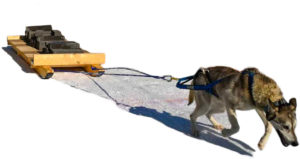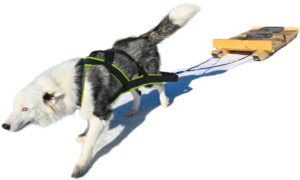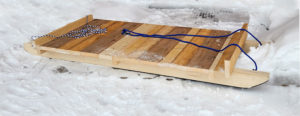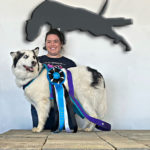BEGINNER FAQ's TO
WEIGHT PULLING
What is a Canine Weight Pull?
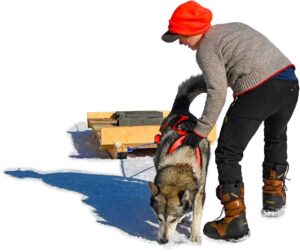 Canine weight pull is a sport in which a single dog, equipped with a specially designed weight pulling/freighting harness, pulls a cart or sled loaded with weights over dirt, carpet, snow or even rails, a specified distance (16 feet) within a specified amount of time. It is a modern adaptation of a bygone era, when dogs were used as freight animals to move cargo.
Canine weight pull is a sport in which a single dog, equipped with a specially designed weight pulling/freighting harness, pulls a cart or sled loaded with weights over dirt, carpet, snow or even rails, a specified distance (16 feet) within a specified amount of time. It is a modern adaptation of a bygone era, when dogs were used as freight animals to move cargo.
During a W3PO weight pull match, dogs are divided into classes by the dog’s weight. The dogs are asked to pull a cart or sled 16 feet in 60 seconds. Dogs who successfully complete a round are eligible to pull increasingly more weight until a winners in each class are found. In addition, there are two dogs that are the overall winners of the match: the dog who pulls the most weight and the dog who pulls the most weight per body lb.
Each W3PO match, a dog can earn points towards various titles. Some are geared towards beginner dogs, like the Weight Pull Aptitude title for dogs who have a qualifying pull at three different matches. Other titles recognize the heavy pullers, like the Weight Pull Dog Superior on Snow title, for dogs who have pulled 15% of their body weight during at least three different matches on snow.
What is the W3PO & how much time are the dogs allowed?
 The World Wide Weight Pull Organization (W3PO) allows each dog 60 seconds to pull the load. If, however, the load is moving forward when time expires, the dog is allowed to complete the pull as long as the cart/sled does not stop its forward motion.
The World Wide Weight Pull Organization (W3PO) allows each dog 60 seconds to pull the load. If, however, the load is moving forward when time expires, the dog is allowed to complete the pull as long as the cart/sled does not stop its forward motion.
Is there any way to make a dog pull the load if the dog does not want to pull the load?
- No! Weight pull dogs must want to pull! If they do not want to pull the load, they won’t. Period. Dogs have even been seen turning completely around and sitting down with their backs to their handler. In these cases, there is nothing a handler can do except take the no-pull.
What's the difference between novice class and open class?
Novice:
Minimum age: 10 months
Leashes are allowed to coax the dog only
Maximum limits on how much weight pulled
Open:
Minimum age: 1 year
No leashes allowed
No maximum limits on weight pulled
What happens if the dog is not able to pull the load?
- If the dog does not pull the load within 60 seconds or is given help to move the load (handler grabs harness and pulls and/or handlers push the load) it is considered a foul.
Are there other ways to foul?
- A handler can get a foul by touching their dog while pulling or baiting them to pull with treats or toys. The dog can get a foul by tangling in the lines. Dogs are allowed two fouls, after the second foul they must withdraw from the event.
- If the handler is aggressive, harsh or abusive with the dog, that is an automatic disqualification. No exceptions!
How much can a dog pull?
- This varies depending on the dog, the handler, weather and the surface they are pulling on but we have seen dogs pull as more than 100% times their body weight on rails.
How big do the dogs have to be?
- There is no minimum or maximum size dog for weight pull. In fact, many small dogs have proven themselves capable of some impressive feats of strength. Dogs are divided by weight class so that they are only competing against similar size dogs.
How are the dogs trained?
- Handlers use a variety of training techniques, but positive reinforcement with praise and treats is a favorite. Although treats, noise makers, and enticement props are banned during the actual pull period, most dogs have a reward of some sort waiting for them back at their crates, and they know it.
Why do some dogs bark and jump in their harnesses?
- Most dogs in competition are extremely excited. Handlers want to see their dogs have a good time, so they encourage their dogs to enjoy themselves.
Do the dogs earn titles for weight pulling?
What type of sled or cart is used? What do they mean by “surface?”
Can I cheer for my favorite dog(s)?
- W3PO encourages spectators to cheer for any and/or all competitors, however, we do ask that you hold your cheers and/or applause until the dog has completed the pull. Some dogs hear the reaction from the spectators and think they have completed the round and stop pulling.
Why do some handlers call their dogs and others stand behind and drive them?
- The dog’s handler, usually its owner, has the choice of standing in front and calling the dog or standing behind the sled/cart and driving the dog. The decision about which method to use is based on the individual training techniques of the handler and the preferences of the individual dog.
What breeds of dogs are allowed to compete at weight pull competitions?
- W3PO welcomes all breeds and mixes to compete at weight pull competitions.
What dogs are not allowed to enter weight pull competitions?
- Dogs who are younger than 10 months for novice class and younger than 1 year for open class.
- Dogs who are older than 12 years and don’t have signed permission from their vet.
- Dogs who are in heat, pregnant or lactating.
- Dogs who are injured or not healthy enough to pull.
- Dogs who are not up to date on their vaccinations.
Can I bring my puppy or non-competitive dog to the weight pull to socialize and watch?
- Spectator dogs are not allowed at competitions. For the safety of your furry friends and ours, we DO NOT allow pets of any kind within the staging and event areas (not even those dogs held on a leash) since they can distract competitors.
What's the difference between a weight pull harness and a recreational harness?
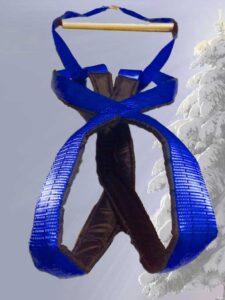 The weight pull harness is specially designed to disperse the tension of pulling large loads over a larger area of the dog. Its crisscross styling and tension bar, which goes behind the dog, under the tail, greatly reduce the possibility of injury to the dog. The padded V-neck of the collar area pulls the harness down away from the dog’s throat allowing him to breath freely while competing.
The weight pull harness is specially designed to disperse the tension of pulling large loads over a larger area of the dog. Its crisscross styling and tension bar, which goes behind the dog, under the tail, greatly reduce the possibility of injury to the dog. The padded V-neck of the collar area pulls the harness down away from the dog’s throat allowing him to breath freely while competing.
Where do I get a weight pull harness?
- Weight pulling harnesses can be obtained from a variety of sources. Some experienced handlers make their own, but most purchase them from a harness maker. They are often custom made to the dog’s unique size and shape.
What other equipment is needed to compete in weight pulls?
- A leash and properly fitting collar are also needed for bringing the dog up to the line and returning him to his crate. No pinch, prong, choke or studded collars are allowed.
Do I have to bring a crate for my dog?
- A crate is not essential to weight pulling, but strongly suggested. When your dog is in a crate you do not have to worry about them being bothered by spectators or loose dogs.
- If the dog is not in a crate, they must be secure in a vehicle or on a leash being held by a handler.
What else should I know?
 Weight pull can seem confusing at first, so don’t be afraid to ask questions. For the full list of rules, check out www.worldwideweightpull.net
Weight pull can seem confusing at first, so don’t be afraid to ask questions. For the full list of rules, check out www.worldwideweightpull.net
